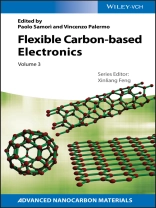This third volume in the Advanced Nanocarbon Materials series covers the topic of flexible electronics both from a materials and an applications perspective. Comprehensive in its scope, the monograph examines organic, inorganic and composite materials with a section devoted to carbon-based materials with a special focus on the generation and properties of 2D materials. It also presents carbon modifications and derivatives, such as carbon nanotubes, graphene oxide and diamonds.
In terms of the topical applications covered these include, but are not limited to, flexible displays, organic electronics, transistors, integrated circuits, semiconductors and solar cells. These offer perspectives for today?s energy and healthcare challenges, such as electrochemical energy storage and wearable devices. Finally, a section on fundamental properties and characterization approaches of flexible electronics rounds off the book.
Each contribution points out the importance of the structure-function relationship for the target-oriented fabrication of electronic devices, enabling the design of complex components.
Daftar Isi
PART I. FUNDAMENTALS
Fundamental Mechanical Properties
Flexible Carbon-Based Electronics
Flexible Circuits
Characterization of Flexible Materials for Electronics
Mechanics of Stretchable Electronics and Soft Machines
PART II. ORGANIC AND POLYMERIC MATERIALS
Transparent Flexible Electronics
Paper Electronics
Flexible Electronics: Materials and Methods
Flexible Displays
Flexible Organic Electronics
Flexible Transistors
Flexible Integrated Circuits
Flexible Semiconductors
Strain Effect in Organic Semiconductors
Flexible Solar Cells
AMOLED
PART III. BIOMEDICAL APPLICATIONS
Flexible Biosensors
Flexible Bioelectronics
PART IV. FLEXIBLE ELECTRONICS BASED ON CARBON MATERIALS
CNT-Based Flexible Electronics
Flexible Sensors
Flexible Electronics with 2D Materials
Wearable and Stretchable Electronics
Role of 2D Materials in Flexible Electronics
Characterization of Graphene Flexible Displays Under Bending and Stretching
Flexibility Vs Electronic Properties of Graphene, New Properties, Negative Curvature
Flexible Solutions to 2D Materials
Printing 2D Materials
Graphene Oxide Based Flexible Devices
Diamond Flexible Electronics
Flexible Batteries
Tentang Penulis
Paolo Samorì is full professor of Physical Chemistry and senior member as well as deputy director of the Institute of Science and Supramolecular Engineering of the University of Strasbourg and the National Center for Scientific Research where he is Director of the Nanochemistry Laboratory. His research interests span applications of scanning probe microscopies, supramolecular electronics and the fabrication of molecular-scale nanodevices. Paolo Samorì has received numerous awards, including the IUPAC Prize for Young Chemists in 2001, the Vincenzo Caglioti award in 2006 granted by the Accademia Nazionale dei Lincei, the ‘Nicolò Copernico’ award in 2009 (Italy), the prix ‘Guy Ourisson’ in 2010 du Cercle Gutenberg and the CNRS Silver Medal in 2012.
Vincenzo Palermo is the leader of the research unit ‘Functional Organic Materials’ of the National Research Council of Italy (CNR). In his work, he uses nanotechnology and supramolecular chemistry to create materials based on organic semiconductors and graphene for electronics and energy applications. He is one of the founders of the Graphene Flagship European initiative, and leader of the flagship work package on nanocomposites. Vincenzo Palermo has been awarded the Lecturer Award for Excellence of the Federation of European Materials Societies, as well as the Research Award of the Italian Society of Chemistry (SCI).












